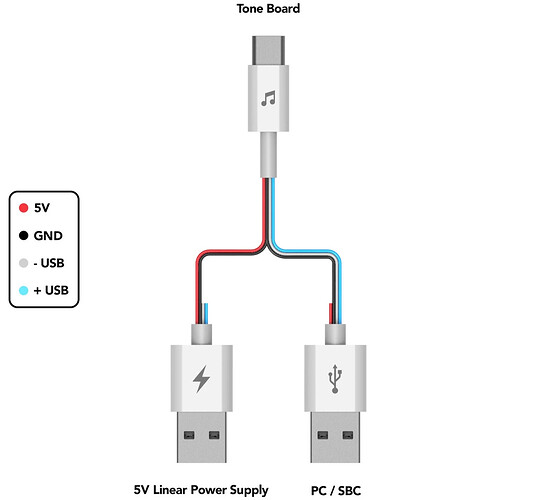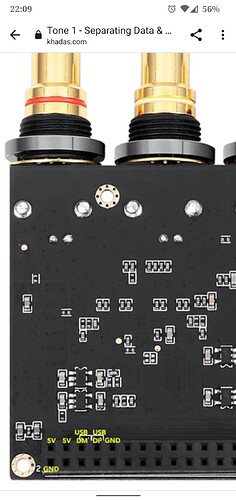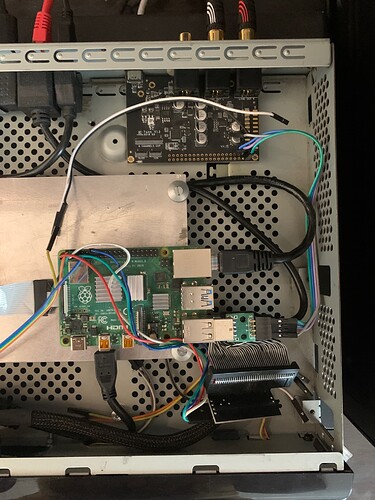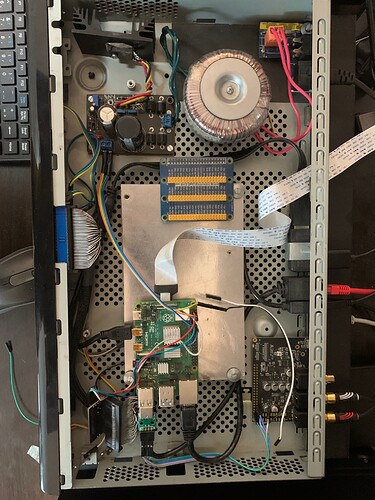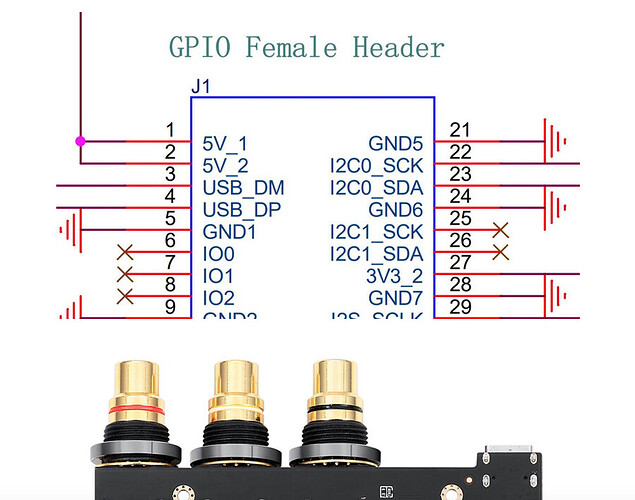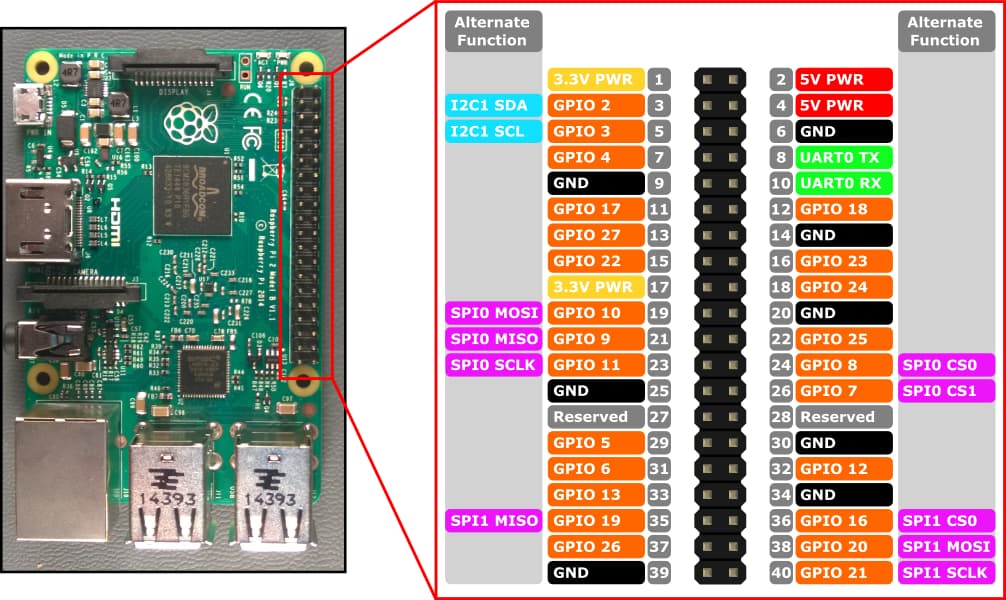you can probably try it and see if you don’t have the alsa problem or if the tone1 is no longer selectable in settings/playback options.
I did a try, results as follows:
- KTB 2 wires usb from Pi (d+/d-) and separate power from a LPS, Pi by separate smps - it did not works. OS did not see usb audio.
- KTB 3 wires usb from Pi (gnd, d+, d-) and 5 v supply in parallel for both KTB and Pi from same LPS - it works.
Common grd for KTB and Pi did the trick.
This come by this picture with common gnd between PS and Pi.
nice found 
so we can conclude that 5 volts plus/minus on pin 1 and pin 21 and data + / - does not work with the tone1 in combination with a raspberry pi.
and in the way as in my initial post it also works only the power supply consumes too much current/ampere
because of this modification you can now notice that the power supply to the heatsink no longer gets so hot, or does it not matter?
That was the old way of connection you always Needed to combine the gnd.
okay so you should always use option 1.
It does not matter as both Pi and KTB use same supply.
More than that, I have also an 7 inch LCD plus OLED 16x2. So much more ampere.
My plan is to use a Meanwell for Pi and LPS for KTB.
I tried this with an old USB-C cable, unfortunately it doesn’t work for me. Toneboard is not recognized in Volumio.
which usb c cable did you use, the one you got with it or a different one?
And if you used the original, what color is the USB-C cable?
I think I was not so clear. The picture that I posted give me the idea to make common gnd. I did not use usb-usbc cable, only wires.
I use gpio on KTB, meaning Pi usb2 → usb male to 4 pin adapter → 3 wires to pin 3, 4 and 21 of KTB.
The LPS goes to Pi gpio pin 4 with 5v and in the same time to gpio pin 1 of KTB.
So no use of 5v from usb.
are you sure this is correct?

To power the Pi feed with 5v at gpio pin 4, nothing to do with usb.
I will make a picture.
Oké, thanks.
now i understand what you mean.
in your case you can use one power supply to power the raspberry pi and power the tone1 without using the usb power.
in my case I use two separate power supplies and as soon as power is applied to pin 1 and 21 of the tone1 the usb power of the raspberry pi automatically switches off.
pin 1 and 2 on tone1 is 5 volts, 21 is ground, 3 and 4 data +/-
on raspberry pi gpio 4 is 5 volts.
if you look closely at the photo, the green wire is ground and is correct.
uhm i was looking from the top it’s 21 / gnd
komt omdat ik de foto van boven had en de schema’s via de onderkant zijn.
it’s all still work in progress and tangled up in wires.
I also have a khadas tone1 in it and the power supply also got quite warm and now only a small silent cooling fan with heat sensor built in it.
for the time being it works fine and the powersupplay now stays cool.
I did some additional tests and my type of connection is not really fine.
I mean on cold boot KTB is not seen by system and i have to switch off/on KTB to be seen. For restart there is no problem.
Two items found on khadas forum:
- "I finally got to the bottom of the problem (I think)
Problem was my external linear regulated PSU: When it’s “cold” and I switch it on, it takes it some time to stabilise at 5VDC. It’s probably less than 1 second, but it’s long enough to put the Tone board is some kind of wrong state in which the sound is heavily distorted.
Easy workaround for me to switch off and on the “warm” PSU quickly, just so the Tone board is reset and gets the stable 5VDC upon restart."
This is somehow in line with my setup when i do switch on/off. Also I notice there is delay for KTB to be power on when feed by usb (i observe white led is on later).
- " Look at the TB schematic for answers. Power from the USB-C socket (DCIN_VBUS) is used as a signal by U12 to switch the USB data connection to the XMOS between the USB-C socket and the GPIO header input. You need 5V on the USB-C for its data connection to be used. Diodes D1 and D2 prevent either ‘5V’ supply backfeeding into the other, but there’s no formal switching - whichever is the higher voltage ‘wins’. In your case the easiest option is to get a USB B connector to wire to the GPIO header USB data connection, while supplying power from your linear supply to the GPIO power pins.
Incidentally I just noticed there are no resistors on the USB-C CC1 and CC2 pins. This will probably prevent a USB C to C connection working because there’s no indication to the host that a device is connected."
I dont know how to take this, but my understanding is I need vbus to usb-c and should be lower than the voltage provided by LPS. From the same forum:
“I am using the Tone 1. May be there is a difference. I tried it on several computers and smart-devices. Always same result: without Vbus, does not recognize the tone.
The sulution I figuered out is as follows: I soldered a 10k resistor into the 5 V Vbus-line. The voltage drop is such, that all power will be taken from the GPIO-connectors (connected to an external LPS). But there still is a 0,2 mA current on the vbus and obvously this is enables the Host to recognize the Tone1.”
This is line with second finding.
@ michel8166, can you check if there is any voltage difference between Pi and KTB?
